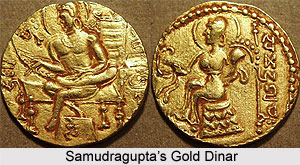 The conquests of Samudragupta had given him the title `Alexander of India`. Such an enormous conquest was guided by the sole aim of Samudragupta to bring about a political unification of India under his own supremacy and himself becoming the Ekrat or the sole ruler. Samudragupta set out to expand the boundary of his kingdom and adopted the policy of "Digvijay". The Allahabad Prasasti delineates a vivid description of Samudragupta`s military campaigns.
The conquests of Samudragupta had given him the title `Alexander of India`. Such an enormous conquest was guided by the sole aim of Samudragupta to bring about a political unification of India under his own supremacy and himself becoming the Ekrat or the sole ruler. Samudragupta set out to expand the boundary of his kingdom and adopted the policy of "Digvijay". The Allahabad Prasasti delineates a vivid description of Samudragupta`s military campaigns.
According to the description provided by Harisena in the Allahabad Prasasti, it was clear that Samudragupta undertook two campaigns in Aryavarta or northern India. There are descriptions of those kings who had been defeated by Samudragupta during his military expedition in the northern and southern territories.
Scholars have opined that the conquests of Samudragupta can be broadly classified into four categories. The four categories are - his conquest against the kings of south, conquest against nine kings of Aryavarta, conquest against the Atavikas and the five frontier kingdoms and nine tribal states and lastly the conquests of some independent and semi-independent principalities in the remote areas. These kingdoms were compelled to offer allegiance and tribute to Samudragupta.
Samudragupta at first thoroughly subjugated the neighbouring kings in the Ganga Yamuna valley and consolidated his position in the north before he set out for his military conquest in the territories of south. Samudragupta defeated the kings Achyuta of Ahichchatra, Nagasena of Mathura and Ganapati Naga of Padmavati and also the prince of Kota family, who constituted a formidable resistance against Samudragupta. The region of Ahichchatra has been identified with Ramnagara and Bareilly district of Uttar Pradesh. Nagasena and Ganapati Naga were the Naga princes who ruled Mathura and Padmavati in Gwalior. The Kota family was concentrated in the Sarasvati region of Uttar Pradesh. Samudragupta routed the league formed by these allied powers in the battle of Kaushambhi. As a result he became the sovereign authority of the vast tract of Ganga Yamuna valley. He consolidated these kingdoms under his own supremacy and annexed it with the Gupta Empire. From Allahabad Prasasti composed by Harishena, it is known that he conducted the military operation in Aryavarta from the region of Purushpura.
A great conqueror, Samudragupta brought political unification within India. He set out for the conquest of southern India or Deccan. Historians have opined that Samudragupta personally did not lead in all campaigns. Being a shrewd diplomat, Samudragupta deviated from the policy of Digvijay in Deccan or south India. In his southern campaign Samudragupta followed in the footsteps of the Mauryan Emperor Ashoka, i.e. the policy of Dharmavijaya. It was guided by three principles: `grahana (capture of the enemy), `moksha` (liberating him) and `anugraha` (favouring him by reinstatement of his kingdom). He did not annex the kingdoms of the local rulers of Deccan; rather he reinstated their kingdom under his own authority. However the historians have different theories regarding his conquests in South India.
Samudragupta defeated as many as twelve kings in course of his campaigns in south India or The Deccan. The identification of the kings defeated by Samudragupta proves that his sway extended in eastern Deccan also. He defeated the kings of Kosala, Mahakantara, Kaurala, Pistapuram, Kottura, Erandapalla, Kanchi, Vengi, Avamukta, Palakka, Devarashtra and Kushalapura.
Samudragupta further extended the boundary of his Empire by conquering the Atavika kingdoms from the forest kings. Atavika or the forest kingdoms extended from the regions of Ghazipore district in Uttar Pradesh to Jabalpore in Madhya Pradesh. The sweeping conquest of Samudragupta in north and south made him the paramount ruler in India. There were five kingdoms and nine tribal states on the frontier, which became his vassals and paid him tribute, obeyed his orders and offered him homage. Apart from these, several tribal states also became his vassal, which included Samatata, Davaka, Kamrup, with Guwahati district. Among those tribal states mention may be made of the Arjunayas, Madrakas and Yaudheyas.






































